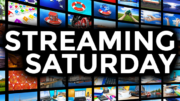Knowledge is power. Today, we’re used to being able to know practically everything. We know who voted for what on a every reality show, and we know far too much about certain famous people. Our computers and devices gather information constantly and companies like Google and Facebook use it to try to sell us more and more of the things we actually might buy.
Believe it or not, in the 1940s this was a revolutionary concept.
When radio was king
Radio was a revolution in the 1920s and 1930s. Imagine life without it. Your evenings were spent with books, or actually talking to each other. Some people listened to records or played the piano. Mostly, they were quiet. Americans went to bed not long after dark, especially those who had yet to put in electricity. Believe it or not, 100 years ago that was still a decent number of folks.
Now imagine for the first time you can sit still, in your home, and get a never-ending stream of live entertainment. You can learn, laugh, and be connected for the first time. It must have felt like a revolution.
Back then, no one knew what to do with what we eventually called “mass communication.” Should all programs be ad-free? Should sponsors’ names be mentioned during the program? There were so many questions. Among them was, “how do I even know if my ad is working?” It would take 15 years before there was a good way to answer that question.
Enter Arthur C. Nielsen
Neilsen, the guy who founded that company that’s still around, was an early statistician with an idea. He wanted to know which radio programs people listened to. He thought radio stations would pay for that information. Of course, he was right. He pioneered the use of the Audimeter, which seemed at the time like super high technology. There’s a photo of it at the top of the article.
So, and I swear I am not making this up, the Audimeter worked by recording the physical position of the radio dial. When people turned it, the Audimeter recorded the motion on a long string of paper. Then later, scientists would analyze the paper, trying to match times and the movement of the dial. Yes, amazingly this is what science was like 80 years ago. This is where it all started.
Ratings weren’t everything, they were the only thing
For about 75 years, Nielsen ratings (and their radio counterpart Arbitron ratings) were the way broadcasters lived and died. Shows were saved or killed purely on their ratings. Arthur Nielsen built a whole world around his measurement equipment and for a long time he was the king of that world.
What changed? Streaming video. With internet-delivered video, content providers don’t need some outside company to tell them how their stuff is doing. They can measure it far more precisely themselves. For streaming video’s first decade, Nielsen merrily ignored the internet. They focused on providing feel-good numbers to broadcasters who were still anxious to pay for good data. As recently as four years ago, that was still the dominant business model.
Nielsen still has an (obviously smaller) role to play in measuring performance, but it could become even smaller. If the ATSC 3.0 standard for broadcasting is fully implemented, broadcasters will be able to measure antenna TV viewers as easily as they measure online ones. You may think that ATSC 3.0 is all about 4k, but really it’s about tapping the potential of antenna-equipped smart TVs. That move may finally kill Nielsen and put to bed the legacy that started with the Audimeter.
This article was inspired by one at Paleofuture.





